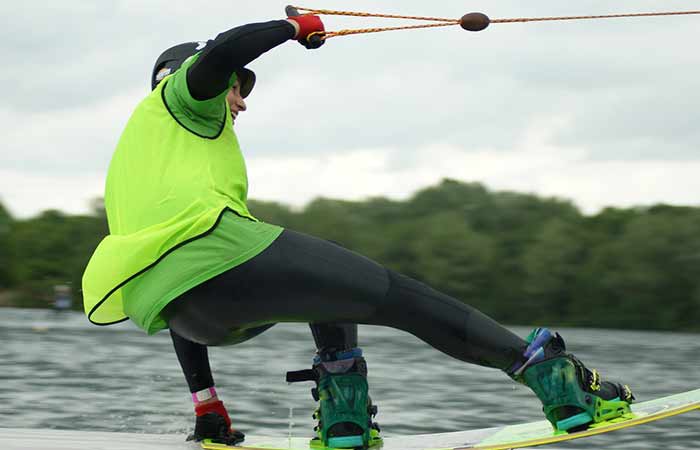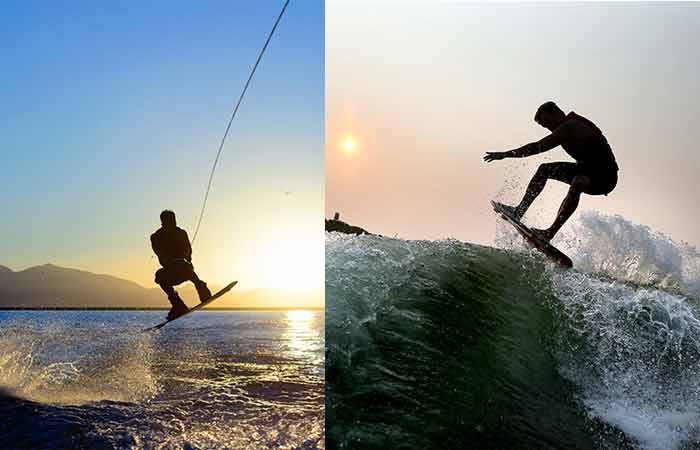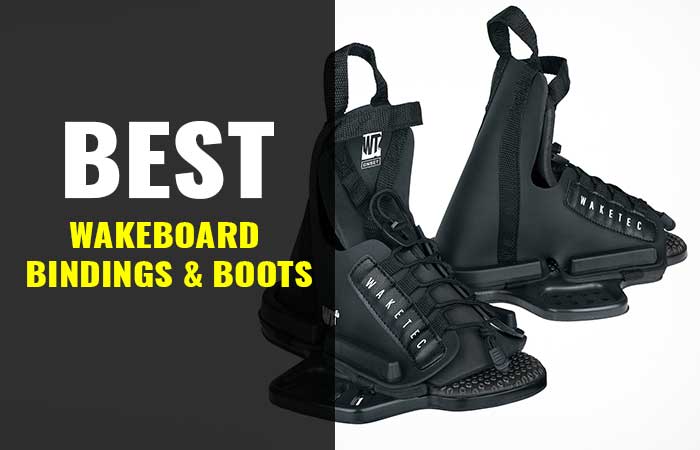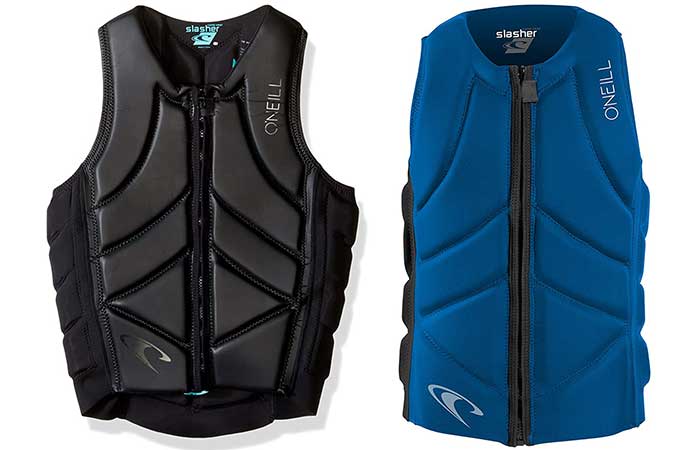How to Wakeboard: A Basic Beginner Guide+Tips
Wakeboarding gives you the thrilling sensation of being pulled across the water while you’re balanced on a board. Here is a guide on all the basics you need to get started.
What is Wakeboarding?
Wakeboarding is a sport whereby you stand on a shortboard with foot bindings (Wake Board), and then you’re pulled by a motorboat across the water. The towing mostly happens off a crest so that you can perform aerial maneuvers. The most remarkable aspect of wakeboarding is performance or midair stunts.
Typically, riders are pulled by a rope attached to a boat, but winches and cable systems can also pull you, and you can be towed by other motor vehicles like all-terrain vehicles, watercraft, trucks, and even cars.
You can wakeboard for pleasure or on a competitive level.Wakeboarding is oftenreferred to as the younger and more popular sibling of waterskiing.
Over the last three decades, wakeboarding has developed from a blend of waterskiing, and snow and land-based board sports, to a popular sport.
How to Wake Board
The following are the steps wakeboard especially for the first time
Step#1 Get the right Equipment & Gear
You need the following equipment and gears for your wakeboarding learning session
Wakeboard
Choosing a wakeboard can be dicey; you have to weigh various factors – length, number of tips, graphics, etc. The size of your wakeboard should be hinged on your weight and height. As a newbie, you should seek the advice of the sales team at the wakeboarding shop. These guys test all the gear that comes into the market, so they should point you to a suitable wakeboard.
Tip
- You should go for a double-ended or twin tip board with upward-facing lips at the edges as a beginner. The latest double-ended boards are lighter and will allow you to jump easily. The boards will also allow you to shift the direction of your board (fakie) with ease.
- Fins enable you to navigate your wakeboard. Various types of fins suit different skill levels and wakeboarding styles. Your board’s fins should therefore be hinged on your riding style.
The bottom line is, you should seek advice before you settle for a given wakeboard.
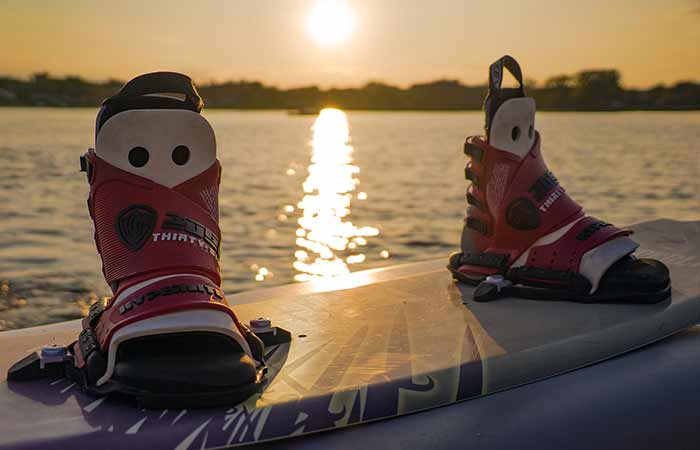
Wakeboard Bindings &Boots
It’s with the wakeboard boots or wakeboard bindings that you fasten your feet to your board. There is a wide range of waterboard bindings, from bungee bindings to high back boots.
You should ideally go for boots that fit your feet and feel comfortable. Again, the sales guy at the wakeboarding shop will point you in the right direction.
Tips
- As a beginner, you shouldn’t go for a pricey wakeboard or wakeboard bindings; your style riding style will evolve with practice and so the type of board and binding you need will change.
- If you’ll share your board with many other people with varying foot sizes, bungee or sandal binding is ideal. It’s built with beginners in mind and can suit various foot sizes. They are also cheaper.
Boat/Cable
Boat: When wakeboarding, you’re pulled by a jet-ski or boat, and you get to use the wake to surf or do tricks; it’s why the sport is called wakeboarding. You can board in all water bodies that offer enough space for towing, be it rivers, lakes, the sea, or the ocean. There are numerous wakeboarding locations in the US and across the globe; we’ll discuss them below.
Cable: If you’re not fortunate enough to access a boat or some motorized vehicle, you can opt for overhead cable tows. These cables are designed based on the engineering and technology that undergirds the drag lifts you find in ski resorts. The cables may even be preferable because they are environmentally friendly and cheaper.
Wetsuit
The type of wetsuit that’s suitable should be hinged entirely on weather conditions – how cold is the water you’ll be wakeboarding in? Typically, riders need to wear thicker wetsuits (4-5mm neoprene) in winter and thinner wetsuits (2-3mm neoprene) in summer.
However, you should note that the thicker your wetsuit is, the more it will restrict your movement.
Tip
- Some wetsuits brands are thick with thinner arms; they’ll therefore keep you warm without overly restricting your movement.
- In icy conditions, membrane drysuits are ideal. They are almost watertight. So with drysuits, you can keep warm by wearing an undersuit or warm clothes underneath.
Helmet
Whether you’re a wakeboarding pro or a beginner, you need to wear a helmet. When boarding, you travel fast amidst obstacles that can be dangerous. So you should consistently wear your helmet,
Wakeboard helmets are built specifically for watersports, so you shouldn’t use your cycling helmet while boarding. The wakeboard helmets are water-resistant, lightweight, and well ventilated. They are also often lined with neoprene, which ensures they’re not waterlogged.
Buoyancy Aid
When wakeboarding, you should wear buoyancy aids just like when you’re kayaking or windsurfing. Your buoyancy aid keeps you afloat as you wait for your boat to come for you – without it, you have to swim till the boat picks you up.
Buoyancy is also vital in emergencies. Wakeboarding is an extreme sport; you can be knocked unconscious. In this case, it’s your buoyancy aid that will keep you afloat.
standard buoyancy aid. But for seasoned wakeboarders, an impact vest is ideal. Impact vests protect the torso and absorb shock when a rider hits an obstacle or water at speed.
Tips
- Nylon vests are cheaper and long-lasting. Besides, you can use them in other sports like knee boarding and skiing.
- Conversely, neoprene vests are pricier. But they offer better floatation and warmth and are much more comfortable.
Step #2. Get into the Water
First, you need to get your gear on and your board on feet. If you’re using a full cable, you’ll start from the dock using a kneeboard. If you’re using a boat, you’ll have to get in the water.
Depending on the season and location, the water may be freezing. But don’t panic; take a few minutes to relax. If water splashes into your mouth, spit it out.
With your buoyancy aid on, you will float with your wakeboard in front of you. While swimming skills are helpful, you don’t have to be an exceptional swimmer.
Step#3 Water Start
Stay calm and relaxed; this will help you gain balance much more quickly. Bend your knees to your chest.
Stretch your arms up front, and ensure your elbows are not bent, hold the handle in a relaxed but steady manner.
When your handle pulls forward, shift with it to balance atop your board (while you’re in couched position). This position will help you gain the stability needed for you to stand up – the slower you shift, the easier it’ll be for you to gain balance.
Once you’ve gotten comfortable in this position, slowly rise with your arms still extended. At this point, boat or cable speed will pick up.
Once you can stand (with your knees still bendy and soft), and once you gain stability, shift the handle to your side and align it with the ‘leading hip.’ Then look across your ‘leading shoulder’.
You should now be able to glide on water in a wakeboarding position.
Which Foot Should You Put Forward? (Your Leading Shoulder/Leading Hip)When boarding, you’re either regular (you put your left foot forward) or goofy (you put your left foot forward). This will happen intuitively ones you’re being towed.
If you’ve surfed, skated, or snowboarded before, you likely know what works for you. The only way of knowing your leading hip or leading shoulder is by tying and feeling what works best for you.
What to do when you’re up-Beginner Techniques
Once you’re gliding on the water with a breeze on your face and water splashing from your feet, you’ve made it. For most, this all they need to delight in the sport.
But if you want to push it to the next level, here are the core skills you need to cultivate.
Carving
Like in most board sports, to carve, you should position your heel on one edge of your board and place your toes on the other edge. Your board will then shift to the edge you’ve put pressure on. Start with the gentle heel carves and then move to the toeside carves.
Switch
Riding switch means riding with your non-leading hip forward (if regular, shifting to goofy).
To get your wakeboard to switch, you should first balance squarely on your board (not on any of the edges) and then bend to the farthest point you can. Then slowly shift the handle from the leading shoulder to a point in front of you, all while your knees are bent.
This shift will, for a second, tilt your board to 90 degrees (slide position). Then move your handle and align it with the other hip.
Ollie
A wakeboard ollie is no different from a snowboard or skateboard ollie. It essentially entails you jumping from flat water into or over something. You start with imaginary obstacles and the aim for boxes and rails. Press your board down using your back foot and then scoop your front foot upwards. A useful tip for getting your groove on is to bounce a few times to break the water tension.
Safety Tips
- Always wear a life jacket
- Use the wakeboarding stance recommended for beginners. That way, you’ll easily navigate and control your board. The ideal posture for beginners is to have the rear binding far back and at zero degrees. Your weight should press the rear fin downwards. You should position the fore binding at a 15 to 27-degree angle; it should point slightly to your wakeboard’s fore-end.
- Always have a spotter who’ll point out your position to the driver and keep an eye for any water obstacles and approaching boats.
- Put the best foot forward – you should use the foot you intuitively use to regain balance.
- Balance your weight correctly. When rising to a standing position, about 60% of your weight should be on your forefoot. You should then balance your weight evenly once you’ve stood.
- Opt for a shorter rope (30-50 feet); it makes it easier for novices to get out of water.
- Your to handle should be low. It’s easier for beginner to stay up when your handle runs parallel to the water’s surface.
- Use the right boat speed. The recommended maximum speed for wakeboarding is 14 to 19mph.
Best Places/Waters for Wakeboarding
Lake Shasta, CA
Lake Shasta is considered one of the finest wakeboarding lakes in the US. It has four arms which have separate lakes and a central lake that’s close to the dam. Besides, it has thousands of coves and inlets that you can explore while there.
Colorado River, US Southwest
Colorado River is one of the top water-ski spots in the US, thanks to it’s still and cool water and hot weather. Summer is a particularly great time to visit because there are always numerous thrilling activities going on.
TSR Extreme Sports Complex, TX
With the Texas Ski Ranch Complex, you don’t need a boat or jet-ski to wakeboard. They have a fantastic cableway for wakeboarders of any skill level. Besides, in the ranch, you’ll also have access to a coach, a Mastercraft towboat, and a professional driver – it’s wakeboarding heaven.
Lake Havasu, AZ
The 19.300-acre lake is a very popular boating location in the southwest. Its size, weather, warm water, and proximity to Las Vegas make it one the finest sites for water-skiing in the West.
Turks & Caicos
For the last few years, the small island in the Bahamas has been attracting droves of wakeboarding pros and amateurs. This is thanks to its stunningly clear blue water where you can wakeboard and other attractions like wild dolphins and an insane shipwreck that you can explore.
Lake Como, Italy
Is there anything better than boarding with a backdrop of Roman times lakeside villas? That’s Lake Como for you. Besides, it hosts numerous wakeboarding schools and clubs.
Dubai, UAE
To say Dubai offers a mind-blowing backdrop is an understatement. Think of the absurdity of having countless futuristic skyscrapers towering over the water as you board. Besides, it hosts a variety of boats and pulls, so there is something for everyone.
Is Wakeboarding Hard to Learn?
Wakeboarding is relatively easy to learn compared to other watersports. Depending on your prior experience and confidence, you can be carving and popping ollies on your first try.
How Dangerous is Wakeboarding?
Like most sports, wakeboarding has some risks, but that doesn’t mean it is life-threatening or dangerous. As long as you take precautions, you will be fine.
Further Reading on Wakebording
- How to Jump on a Wakeboard
- How to Get Up on a Wakeboard
- Wakeboard Tricks & Names: Easiest to the Hardest
- Wakeboarding vs Wake Surfing
- How to Pick the Right Wakeboard Size-Chart & Guide
- 7 Best Wakeboards + Buy Guide
- Best Wakeboard Life Jackets & Vests for Women, Men & Kids
- Best Wakeboard Bindings & Boots
- 7 Best Wakeboard Towers-What to look for when Buying

![7 Best Wakeboards + Buy Guide [2021]](https://aquaticglee.com/wp-content/uploads/2021/01/best-wakeboards.jpg)
